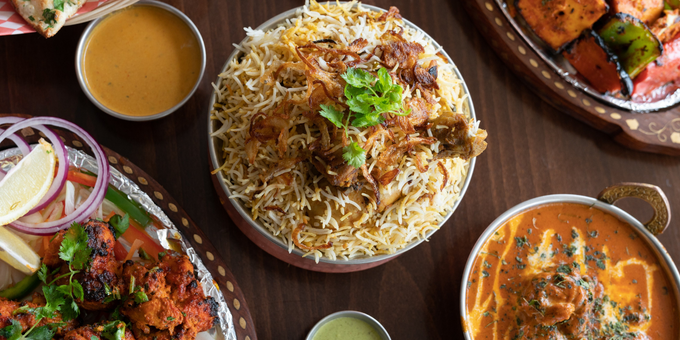From kormas to chickpea curries, Indian cuisine is one of the most versatile, adaptable and nutritious options out there. But when you’re going out to eat, things can be a little harder to navigate – with just a few poor choices, you may end up leaving the restaurant with soaring blood sugars and a craving for more. Here’s how to navigate your way through an Indian restaurant – from the drinks to the desserts, we’ve got you covered.
Drinks

Avoid this: You’ll want to avoid the fruit Lassi drinks – while the yoghurt in these is loaded with probiotics and calcium, there’s often honey or sugar added, along with blended fruit which tends to be high on the fructose scale. Paneer soda is another one to steer clear of, the reason being that it’s essentially sugar water.
Order this: Chai tea is one of the healthiest drinks around the world and it happens to be an Indian speciality. It’s not only sugar free, but it provides the following healthful properties:
- Rich in cancer-fighting antioxidants
- Promotes heart and gut health
- Reduces inflammation
- Promotes immunity
- Supports healthy skin
Another drink known as Kaapi (Indian-style filter coffee), is another sugar-free, warming option that makes for the perfect after-dinner coffee.
Entrees and mains

Avoid this: Deep-fried entrees like your classic samosas are sneaky sugar smugglers, along with providing you with a dose of hormone-dysregulating trans fats. Take caution with chicken tikka masala and butter chicken. While the latter has a range of beneficial healthy fats from cashews, restaurant-made versions tend to go heavy on the salt, sugar and unhealthy fats, so if you’re out and about, skip this one and make your own delicious, healthy version at home. You’ll also want to avoid the tomato-based curries – the tomato sauce will spike your blood sugars due to its concentrated form and lack of fibre that we’d find in whole tomatoes.
Order this: Entrees and sides like roti, basmati rice, naan bread, steamed veggies, cottage cheese (paneer) and yoghurt are all safe and nutritious options. When it comes to the mains, you can’t go wrong with a classic veggie or korma curry, these tend to be loaded with vitamins and minerals, plus fragrant herbs that render sugar obsolete. You’ll find health-boosting ingredients like fennel, cumin, cinnamon and fenugreek seeds which are known for their anti-inflammatory properties, along with their ability to reduce blood sugar levels, improve digestion and immunity. But it’s worth double checking if there are excess added sugars in your restaurant’s recipe, and ask if they can leave it out. Tandoori chicken can also be a good option, but as always, ask the waiter about any additives.
Tip: Call the restaurant ahead of time to find out if they make any accommodations – some places will be more than happy to keep the sugar out of their sauce, while others stick to a strict recipe. Also do a little net surfing for their website and check out the menu to see if there’s anything that looks suitable. This takes the stress out of deciding in a rush on the night!
Dessert

Avoid this: One of the most popular Indian desserts, known as jalebi, is one worth avoiding – it’s a deep-fried batter soaked in a sugary syrup. Yep, it’s a sugar bomb. Galub jamun is another one to skip; they’re deep-fried balls of semolina-based dough which are then doused in syrup, so you’ve got a double hit of sugar and trans fat.
Order this: Instead of a traditional dessert, opt for a spiced masala tea – it’s aromatic, fragrant and comforting – the perfect end to a big dinner. But if you’re still craving something sweet later, we’ve got the perfect recipe for you – it’s an indulgent, chocolately tart paired with the hero of the dish: cardamom – a classic Indian spice.
Cardamom and Sea Salt Ganache Tart

Serves 16
Ingredients:
- 270 ml can coconut cream
- 2 tablespoons cardamom pods, lightly crushed with a flat blade until the outer husks crack
- 1 teaspoon vanilla extract
- 100 g dark (85–90% cocoa) chocolate, chopped
- Pinch of sea salt, plus coarse sea salt, to garnish
- Berries, edible petals and buckwheat groats, to garnish (optional)
For the crust:
- 1⁄3 cup coconut oil
- 1⁄4 cup rice malt syrup
- 2 cups shredded coconut
- 1 tablespoon raw cacao powder
Method:
- Preheat the oven to 180°C.
- To make the crust, melt the coconut oil and rice malt syrup in a saucepan. Remove from the heat, add the shredded coconut and cacao powder and mix well. Press the mixture into the base and up the side of a quiche or tart tin – no need to grease it – so that the mixture’s approximately 5 mm thick all over. Bake the crust for 15–20 minutes. Remove from the oven and set aside to cool and firm up.
- Meanwhile, heat the coconut cream, cardamom pods and vanilla in a saucepan to a simmer, then turn off the heat and cover with a lid. Allow to steep for 10 minutes.
- Strain the coconut cream mixture into a bowl, reserving 1⁄4 cup in the pan for emergency use later, if needed. Discard the cardamom pods (or save to spice up chai tea). Add the chocolate and salt to the bowl, whisking it through until silky and melted. If the fats separate and your ganache develops a chocolatey cottage-cheese appearance, just add the reserved coconut cream, whisking swiftly to bring it all back together.
- Once silky, pour into the tart shell and refrigerate until the ganache sets (at least 2 hours). Garnish with a pinch of coarse sea salt and berries, petals and activated groats, if desired.
This comes straight from our No Sugar Baking Cookbook – for more delicious, low-sugar recipes, check it out HERE.






Leave a comment (all fields required)